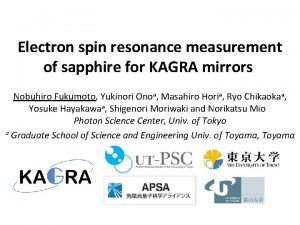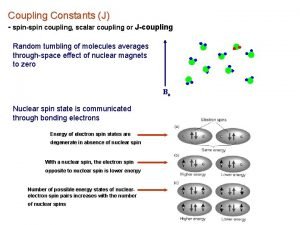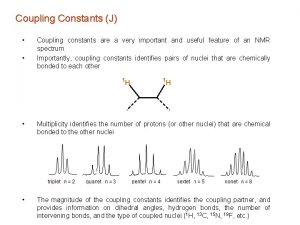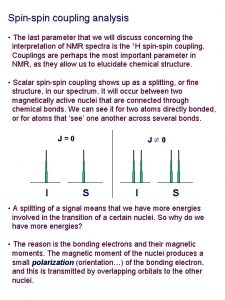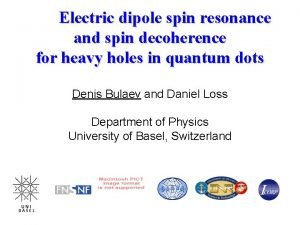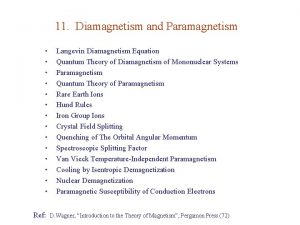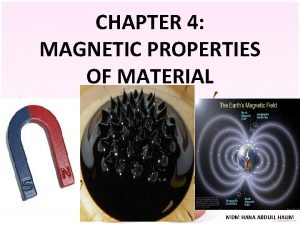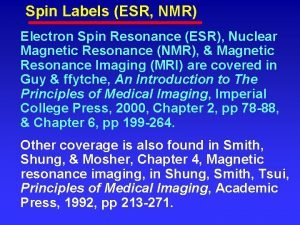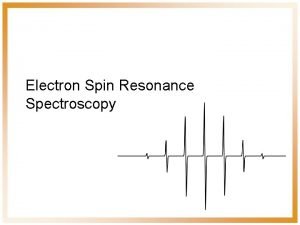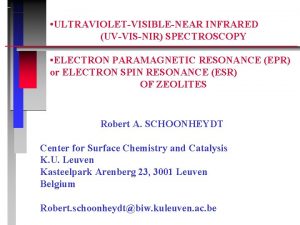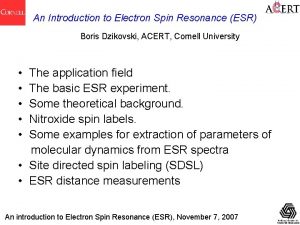Electron Paramagnetic Resonance EPR Electron Spin Resonance ESR








- Slides: 8

Electron Paramagnetic Resonance (EPR) Electron Spin Resonance (ESR) Electron Magnetic Resonance (EMR) EPR ~ ESR ~ EMR What is EPR? Ms = +½ Energy Ms DBpp ±½ DE=hn=gb. B Ms = -½ B=0 B>0 Magnetic Field (B) h n g b B Planck’s constant 6. 626196 x 10 -27 erg. sec frequency (GHz or MHz) g-factor (approximately 2. 0) Bohr magneton (9. 2741 x 10 -21 erg. Gauss-1) magnetic field (Gauss or m. T) EPR is the resonant absorption of microwave radiation by paramagnetic systems in the presence of an applied magnetic field hn = gb. B n= (gb/h)B = 2. 8024 x B MHz for B = 3480 G for B = 420 G for B = 110 G n = 9. 75 GHz (X-band) n = 1. 2 GHz (L-band) n = 300 MHz (Radiofrequency)

Electron Nucleus I (½) S (½) Ms MI +½ +½ Hyperfine Coupling a -½ MS=±½ DE 1 -½ DE 2 -½ B “doublet” +½ E = gb. BSz + (h. A 0)Sz. Iz E = gb. BSz + (a)Sz. Iz (h. A 0 (Hz) -> a (G) via g-factor) Selection Rule DMS = ± 1 (electron) DMI = 0 (nuclear) DE 1 = gb. B + a/2 DE 2 = gb. B - a/2 DE 1 – DE 2 = a

Electron Hyperfine Coupling Nucleus I (1) S (½) Ms MI +½ +1 +0 -1 a MS=±½ DE 1 DE 2 DE 3 B -½ E = gb. BSz + (h. A 0)Sz. Iz E = gb. BSz + (a)Sz. Iz (h. A 0 (Hz) -> a (G) via g-factor) -1 +0 +1 Selection Rule DMS = ± 1 (electron) DMI = 0 (nuclear) “triplet” DE 1 = gb. B + a DE 2 = gb. B DE 3 = gb. B - a

• • Resonance position Multiplet structure Line-shape Intensity (g-factor) (hyperfine network) (line-width, symmetry, etc) (amplitude/area) serve as “finger prints” in the identification & quantitation of the radical under investigation!

What do we do with EPR? We can detect & measure free radicals and paramagnetic species • High sensitivity (nanomolar concentrations) • No background • Definitive & quantitative Direct detection primary species, detected as is e. g. : semiquinones, nitroxides, trityls primary species are detected intact as spin-adduct, ‘spin-trapping’ Species: superoxide, hydroxyl, alkyl, NO Spin-traps: DMPO, PBN, DEPMPO, Fe-DTCs Indirect detection (secondary radicals) Spin-formation : hydroxylamines (Dikhalov et al) Spin-change : nitronylnitroxides (Kalyanaraman et al) Spin-loss : trityl radicals

Can we use EPR to measure free radicals from biological systems (in vivo or ex vivo)? Yes! Radicals from intact tissues, organs or whole-body can be measured. But there is a catch! Biological samples are aqueous and undergo ‘non-resonant’ absorption of microwave energy (microwave cooking!) and hence poor penetration depth. The frequency of the instrumentation is reduced to overcome this problem! What is the optimum frequency? - depends on sample size Frequency ~300 MHz ~750 MHz 1 -2 GHz ~3 GHz 9 -10 GHz Penetration Depth > 10 cm 6 -8 cm 1 -1. 5 cm 1 -3 mm 1 mm Objects studied Mouse, rat heart Mouse tail Topical (skin) In vitro samples (~100 u. L vol. ) Pioneers Halpern et al Krishna et al Zweier et al Hyde et al Swartz et al Zweier et al Hyde et al Zweier et al

What else can we do with EPR? Instead of “spying on free radicals”, we can use free radicals as “spying probes” to obtain functional information from biological systems • A known free radical probe is infused or injected into the animal • The change in the EPR line-shape profile, which is correlated to some physiological function, is then monitored. • The measurements can be performed in real-time and in vivo to obtain ‘functional information’.

Functional parameters from an EPR spectrum In vivo EPR spectroscopy is capable of providing useful physiologic and metabolic (functional) information from tissues Oxygen, p. O 2 Redox status Oxygen, p. O 2 Acidosis, p. H Viscosity Molecular motion Acidosis, p. H Thiols (GSH) Cell viability Viscosity Tissue perfusion width Redox status Cell viability Tissue perfusion amplitude Molecular motion Splitting
